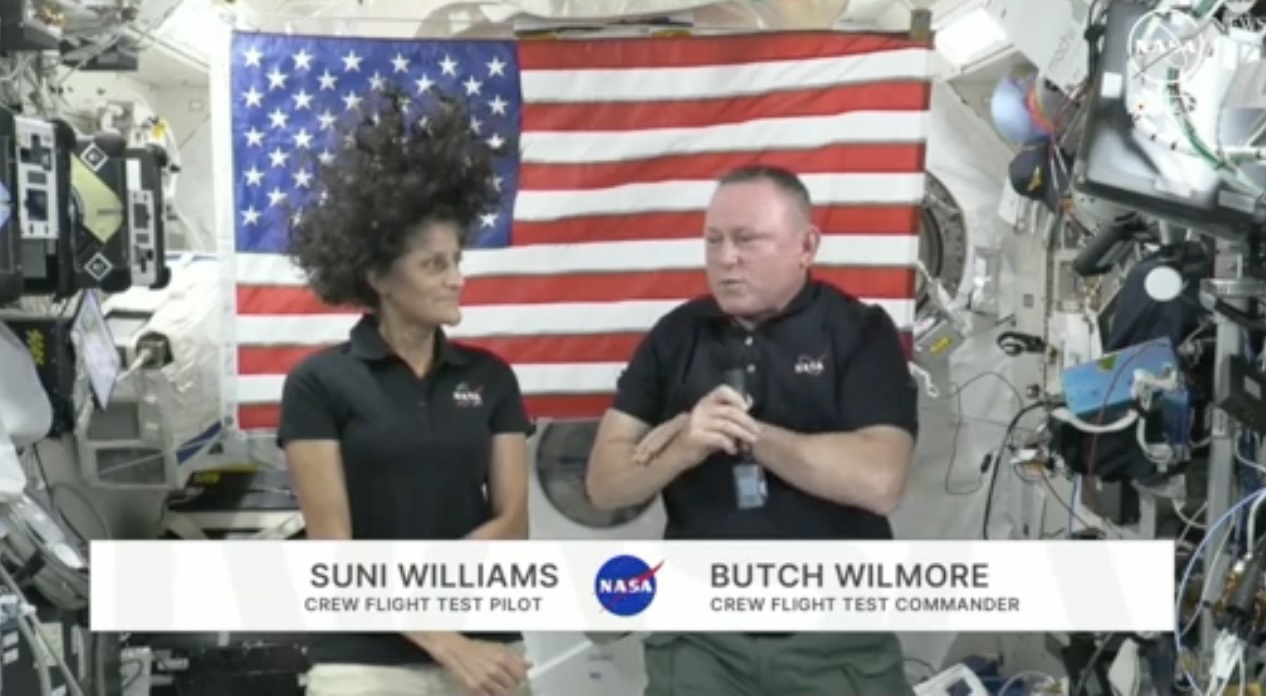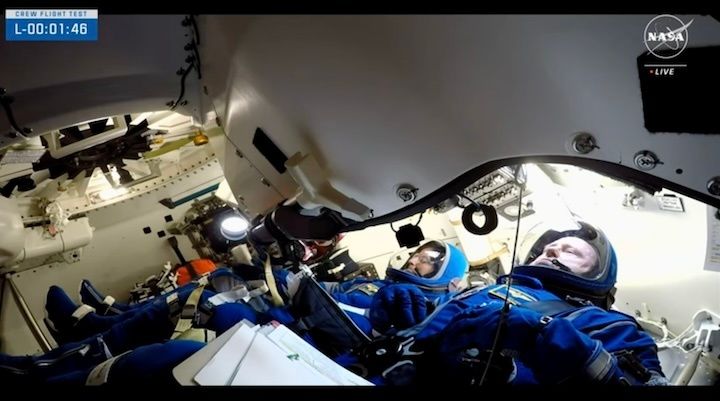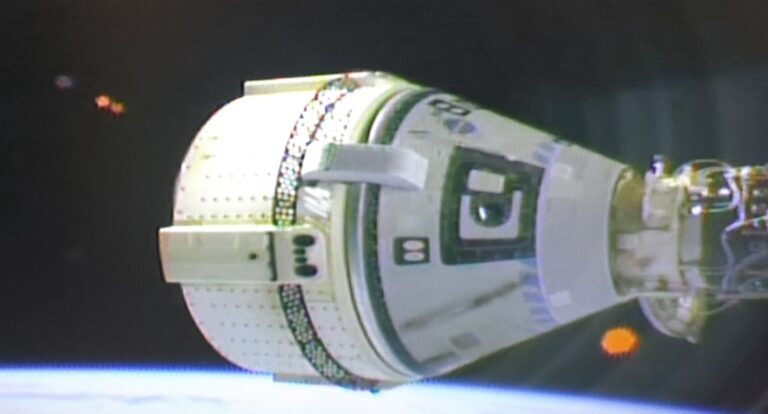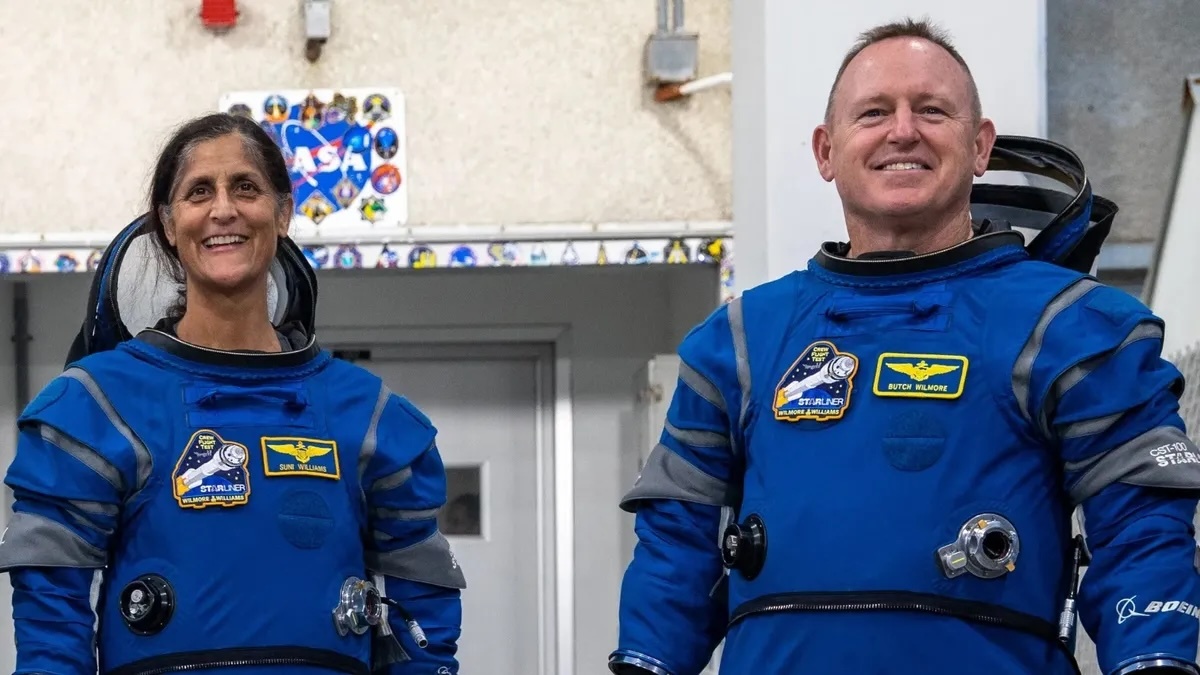12.07.2024
Butch Wilmore and Suni Williams were orginally to return to Earth on June 14.

The NASA astronauts who were aboard the first crewed flight into space on Boeing's Starliner said they are "confident" the spacecraft can get them home safely.
Flight commander Barry "Butch" Wilmore, 61, a former U.S. Navy captain, and Sunita Williams, 58, a former Navy service member, have been aboard the International Space Station (ISS) for more than a month after Starliner experienced several mechanical issues, including helium leaks and a thruster issue.
"We're absolutely confident," WIlmore said Wednesday. He said the pair tested a "Safe Haven procedure," sheltering inside Starliner in the event they needed to suddenly undock from the ISS, and the test went well.
"We've been through a lot of simulations...and I think where we are right now…I feel confident that if we had to, if there was a problem with the International Space Station, we could get in our spacecraft, we could undock, talk to our team and and figure out the best way to come home," Williams added.
Wilmore and Williams lifted off on June 5 from Cape Canaveral Space Force Station in Florida and docked with the ISS on June 6.
The pair were initially expected to spend one week aboard the ISS evaluating the spacecraft and its systems and return June 14. However, Starliner's mechanical issues left the astronauts stuck onboard the ISS with no set return date.
NASA has insisted Wilmore and Williams are safe while they remain onboard the ISS with the Expedition 71 crew. The agency has said the ISS has plenty of supplies in orbit, and the station's schedule is relatively open through mid-August.
"We’re taking our time on the ground to go through all the data that we have before we decide on the return opportunity," Steve Stich, manager of NASA's Commercial Crew program, said during a Wednesday afternoon press briefing. "We're taking time to build confidence in the spacecraft to understand the thruster performance … and also totally understand the helium margins before we undock."
NASA and Boeing say Wilmore and Williams are "integrated" with the Expedition 71 crew aboard the ISS and are helping the crew with station operations as needed, as well as completing "objectives" needed for NASA's possible certification of Starliner.
"Since their arrival on June 6, Wilmore and Williams have completed half of all hands-on research time conducted aboard the space station, allowing their crewmates to prepare for the departure of Northrop Grumman's Cygnus spacecraft," NASA wrote in a recent update.
This week, teams at NASA's White Sands Test Facility in New Mexico are performing ground tests of Starliner's thruster, putting it through similar conditions the spacecraft experienced on its way to the ISS, according to an update on Boeing's website.
The tests will replicate Starliner's docking, when some of the thrusters failed, and what the thrusters will experience between when Starliner undocks from the ISS and touches down back on Earth.
"This testing is trying to replicate what the worst-case thruster saw inflight," Mark Nappi, Boeing's vice president of its Commercial Crew Program, said during the Wednesday afternoon news conference. "So far, we've not been able to replicate the temperatures that we saw in flight, so the team is off talking about that – as a matter of fact, right now – so that they can determine whether or not there's a form of testing, or something in the test that we want to go change, so that we can replicate that situation."
Stich said the tests, and taking one's time with them, are not unusual for a new spacecraft, and because Starliner can be powered from the ISS, it allows the team to use the space station as temporary hangar. He added that he expects the tests to be completed by the end of this week or over the weekend.
Starliner had been plagued by issues even before launch. The flight test was originally tentatively scheduled for May 6, but was scrubbed after a problem with an oxygen valve on a rocket from United Launch Alliance, which manufactures and operates the rockets that launch Starliner spacecraft into orbit.
A new launch date was subsequently set for May 25, but then a small helium leak was discovered in the Starliner service module, which contains support systems and instruments for operating the spacecraft.
Those helium leaks and a thruster issue threatened to delay Starliner's ISS docking, but it docked successfully. Five days after docking with the ISS, NASA and Boeing announced that the spacecraft was experiencing five "small" helium leaks, but added at the time that enough helium remained for the return mission.
Quelle: abcNews
----
Update: 20.07.2024
.
Boeing is closer to understanding thruster failures on its first astronaut flight with latest test
Boeing is closer to understanding what went wrong with its astronaut capsule in orbit, now that testing is complete on a spare thruster here on Earth

Boeing is closer to understanding what went wrong with its astronaut capsule in orbit, now that testing is complete on a spare thruster here on Earth.
The Starliner capsule has been docked at the International Space Station since June 6. It should have returned with its NASA test pilots by mid-June, but thruster failures and helium leaks prompted NASA and Boeing to extend its stay.
Officials said Thursday there’s still no return date for astronauts Butch Wilmore and Suni Williams. Engineers will first disassemble the thruster that was test-fired in New Mexico over the past couple of weeks. Then they’ll analyze the data before clearing Starliner for the trip home.
“We collected an incredible amount of data on the thruster that could help us better understand what is going on in flight,” NASA’s commercial crew program manager Steve Stich said in a statement.
The testing managed to replicate the thruster conditions up until the capsule's docking at the space station, as well as what the thrusters will experience between undocking and descent, according to NASA.
This is the Starliner’s first test flight with a crew aboard.
Quelle: abcNews
----
Update: 27.07.2024
.
NASA says no return date yet for astronauts and Boeing capsule at space station
Officials say two NASA astronauts will remain at the International Space Station until engineers finish working on problems plaguing their Boeing capsule
Already more than a month late getting back, two NASA astronauts will remain at the International Space Station until engineers finish working on problems plaguing their Boeing capsule, officials said Thursday.
Test pilots Butch Wilmore and Suni Williams were supposed to visit the orbiting lab for about a week and return in mid-June, but thruster failures and helium leaks on Boeing's new Starliner capsule prompted NASA and Boeing to keep them up longer.
NASA’s commercial crew program manager Steve Stich said mission managers are not ready to announce a return date. The goal is to bring Wilmore and Williams back aboard Starliner, he added.
“We'll come home when we're ready,” Stich said.
Stich acknowledged that backup options are under review. SpaceX's Dragon capsule is another means of getting NASA astronauts to and from the space station.
“NASA always has contingency options," he said.
Engineers last week completed testing on a spare thruster in the New Mexico desert and will rip it apart to try to understand what went wrong ahead of the Starliner's docking. Five thrusters failed as the capsule approached the space station on June 6, a day after liftoff. Four have since been reactivated.
It appears degraded seals are to blame for the helium leaks and thruster problems — entirely separate issues — but more analysis is needed. The team will test-fire the capsule's thrusters this weekend while docked to the space station to gather more data, said Boeing’s Mark Nappi.
Each of the 28 maneuvering thrusters can fit in a hand and weighs 2 pounds (1 kilogram). The capsule is also outfitted with bigger engines for dropping out of orbit at flight's end. All these are part of a segment that is discarded before landing, which means nothing to study for future flights.
After the space shuttles retired, NASA hired private companies for astronaut rides to the space station, paying Boeing and SpaceX billions of dollars.
This was the Boeing's first test flight with a crew aboard. The initial demo in 2019, flying empty, never made it to the space station because of bad software, and Boeing repeated the test in 2022. More issues later cropped up.
SpaceX has been ferrying astronauts since 2020. SpaceX's Falcon 9 rockets have been grounded for the past two weeks because of an upper-stage failure on a satellite-delivery mission. The longer the stand-down continues, the more likely upcoming crew flights will be delayed.
Quelle: abcNews
----
Update: 29.07.2024
.
Starliner Docked Hot Fire Testing Complete
Spacecraft thrusters tested and helium system checked in second successful docked hot fire test.
The Starliner team completed a docked hot fire test of the spacecraft’s Reaction Control System (RCS) thrusters Saturday afternoon, and monitored its helium system, providing additional data points for the Crew Flight Test’s return to Earth.

With Starliner flight director Chloe Mehring at the helm and Boeing engineers on console monitoring the spacecraft’s systems, flight controllers commanded the sequential firing of 27 RCS thrusters.
“The integrated teams between Starliner and ISS worked extremely well together this week to finalize and safely execute the docked hotfire sequence,” said Mehring, who will lead the Starliner flight control team in the upcoming undocking from the International Space Station.
“Both teams were very happy with the results.”
The one-pulse firings were designed to confirm the performance of each thruster. Aft-facing thrusters were fired for 1.2 seconds and all others for .40 seconds. Between each firing, the team reviewed real-time data and all thrusters performed at peak thrust rating values, ranging from 97-102%. The helium system also remained stable. Additionally, an RCS oxidizer isolation valve that was not fully seated previously, was cycled several times during today’s testing and is now operating normally.
This is the second time the spacecraft has been hot fired successfully while docked, an integrated operation the station and Starliner teams will also conduct during future long-duration missions.
Flight test astronauts Butch Wilmore and Suni Williams were inside Starliner Calypso giving the team on the ground real-time feedback during the test. In preparation for the return home, Wilmore and Williams will participate in two undock to landing simulations next week.
A Flight Test Readiness Review is tentatively planned for late next week, and the data gathered today will be reviewed and included in return flight rationale. While a landing date has not yet been set, opportunities are available throughout August.
Quelle: Boeing
----
Update: 4.08.2024
.
NASA weighs Boeing vs. SpaceX choice in bringing back Starliner astronauts

NASA management has been in deep discussion this week about whether to return the agency’s astronauts on board Boeing’s misfiring Starliner capsule or to go with the alternative of using a SpaceX craft to rescue the crew.
The agency’s concern with Starliner — which flew NASA astronauts Butch Wilmore and Suni Williams to the International Space Station in early June — comes from not having identified a root cause for why some of the spacecraft’s thrusters failed during docking, a person familiar with the situation told CNBC.
NASA this week has been discussing the possibility of returning Starliner empty and instead using SpaceX’s Crew Dragon spacecraft to return its astronauts. There is no consensus among those responsible for making the decision, that person said, calling the outcome of NASA’s ongoing discussions unpredictable given the variety of factors involved.
The Starliner capsule “Calypso” has now been in space 59 days and counting. The mission is intended to serve as the final step toward proving Boeing’s long-delayed spacecraft is safe to fly lengthy crew missions to-and-from the ISS.
The Boeing crew flight was initially planned to last a minimum of nine days. But it has been extended several times while the company and NASA conduct testing both back on the ground and in space in an attempt to understand the thruster problem.
While NASA and Boeing leadership have publicly characterized the extensions as a data-gathering exercise, the concerns raised in recent days reveal that there is less confidence internally on whether Starliner is safe to return the astronauts than the agency has disclosed.
Ars Technica first reported NASA’s mixed opinion on Starliner’s situation. NASA previously noted that SpaceX serves as a backup but has sought to deemphasize that possibility, calling Boeing’s spacecraft the “primary option” for return.
For its part, Boeing says it has the “flight rationale” to return Starliner with the astronauts on board, meaning the company believes the spacecraft can return without too much risk.
“We remain confident in the Starliner spacecraft and its ability to return safely with crew. We are supporting NASA’s requests for additional data, analysis and data reviews to affirm the spacecraft’s safe undocking and landing capabilities,” a Boeing spokesperson said in a statement to CNBC on Friday.
If Starliner returns empty, the most likely alternative would be to bring the astronauts back using SpaceX’s Crew Dragon by removing two astronauts from the Crew-9 mission — currently planned to launch four people in the coming weeks. That would open up two seats for Wilmore and Williams.
NASA did not respond to CNBC’s request for comment on the ongoing Starliner discussions, but told Ars Technica in a statement that the agency “is evaluating all options for the return.”
“No decisions have been made and the agency will continue to provide updates on its planning,” NASA said.
Trusting the thrust
After testing this past weekend, NASA noted that 27 of Starliner’s 28 thrusters appear to be healthy. The thrusters, also known as its reaction control system, or RCS, engines, help the spacecraft move in orbit.
But from an engineering perspective, not having a root cause for why five of the thrusters failed on the flight to the ISS means that risk remains for more thrusters to malfunction during the return flight.
Boeing’s Mark Nappi, vice president of the Starliner program, said during a press conference on July 25 that testing of the thrusters has resulted in “very significant” findings that “are likely the root cause.” But despite that, the company has not identified the root cause yet.
“We’re going to continue to take that hardware apart so that we can finally prove this,” Nappi said at the time.
NASA now needs to decide if it’s willing to trust that the unknown issue with Starliner’s thrusters does not arise again, or even potentially cascade into other problems.
An unpredictable outcome
NASA’s lack of consensus arose when the Commercial Crew Program Control Board met earlier this week to discuss Starliner’s return. PCBs are a standard part of NASA’s decision-making process, dating back to the Space Shuttle era, and are an effort to make sure any risks can be elevated to the highest levels of the agency’s authority.
The PCB, chaired by Commercial Crew program manager Steve Stich, did not come to a decision on whether to move forward with a flight readiness review, the next major agency step toward establishing a date for Starliner to return. The next PCB meeting is expected in the coming days, with NASA noting in a blog post on Thursday that return planning will continue into next week.
If any members of the PCB dissent on the decision to return Starliner with crew, the decision would go up the chain of command until the dissent is addressed. As it stands, the discussions within the PCB do not have a predictable outcome as NASA personnel discuss the level of risk involved on returning crew with Starliner.
Making a choice
NASA often emphasizes that “astronaut safety remains the top priority” for the agency in making decisions about human spaceflight, an inherently risky endeavor.
But the choice NASA faces has further ramifications, which threaten Boeing’s involvement in the agency’s Commercial Crew Program. Already, Boeing’s Starliner losses total more than $1.5 billion due to repeated setbacks and years of delays in developing the spacecraft.
If NASA backs Boeing and returns Wilmore and Williams on Starliner, the agency is accepting a currently unquantifiable amount of risk. A major failure during the return, with the astronauts’ lives at stake, would put NASA leadership under pressure to end Boeing’s contract and involvement in the program.
If NASA decides to send Starliner back empty, it’s a vote of no confidence in Boeing that may lead the company to cut its losses and withdraw from the program.
Additionally, if NASA takes the SpaceX alternative and Starliner returns home without incident, the agency faces blowback from being seen as overreacting to a situation that it publicly declared for weeks was not a significant risk.
Quelle: NBC News
